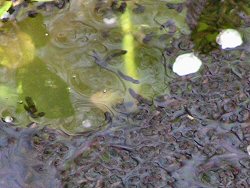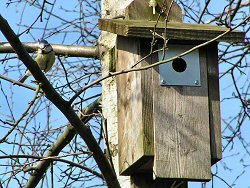Although the weather over the last few days has not been as warm as it was a week or so ago, the garden wildlife continues prepare for the reproductive season.
 Tadpoles on 28th March
Tadpoles on 28th March
Temperatures have certainly been high enough for the frogspawn to develop at an incredible rate. No matter how many times I see it, I am always amazed at how quickly (given good temperatures) the spawn develops into tadpoles. I noticed the first spawn in my pond on 17th March and the picture shown here was taken on 28th March, just 11 days later. When I looked in the pond this evening, the vast majority of the spawn had hatched and the tiny tadpoles had congregated in dense black masses over the remainder of the spawn jelly which they are, presumably, eating.
I continue to see many bumblebees in the garden and around town - many more than I remember seeing last Spring. Perhaps last summer was a particularly productive one for them, or perhaps conditions are just good for the queens emerging from hibernation just now. I have now seen queens of five of the six common garden bumblebees in my garden this year: buff-tailed (
Bombus terrestris), white-tailed (
B. lucorum), red-tailed (
B. lapidarius), early (
B. pratorum) and common carder (
B. pascuorum). I've yet to see the garden bumblebee (
B. hortorum) this year, though I only recognised one of these in the garden last year.
 Blue tit taking nesting material to a nestbox
Blue tit taking nesting material to a nestbox
Unlike many insects, bumblebees are capable of warming up their flight muscles by vibrating their wings and so may often be seen on even quite cold spring days. Butterflies do not have the same tolerance of lower temperatures however, and have been noticeably scarce since the
'glorious 20th'!
There is a fair bit of bird nesting activity going on in the garden including a pair of blue tits (
Parus carduelis) which I first saw taking nesting material to a nestbox hung in a birch tree (
Betula sp.) on March 20th (see picture). We also have a pair of blackbirds (
Turdus merula) nesting in a leylandii hedge and I think that a pair of robins (
Erithacus rubecula) may be building very close by too. For much of the winter I have suspected that a great tit (
Parus major) has been roosting in a nestbox which is hung on the side of the house and this evening while I was out watering some new plants, a great tit became very agitated by my presence. Sure enough, as soon as I was indoors I saw the bird fly into the nestbox and remain there. Whether it is simply still roosting or has progressed onto nesting remains to be seen, though I haven't yet seen any nesting material being taken into the box.